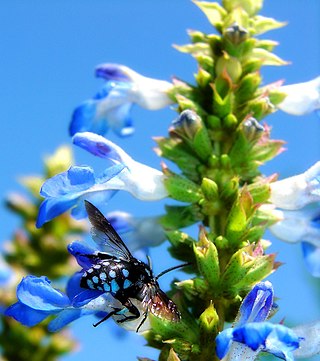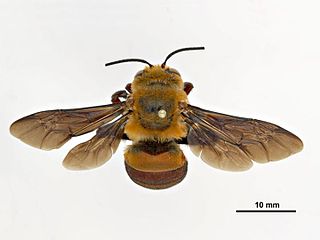
Phalaenopsis, also known as moth orchids, is a genus of about seventy species of plants in the family Orchidaceae. Orchids in this genus are monopodial epiphytes or lithophytes with long, coarse roots, short, leafy stems and long-lasting, flat flowers arranged in a flowering stem that often branches near the end. Orchids in this genus are native to India, Taiwan, China, Southeast Asia, New Guinea and Australia with the majority in Indonesia and the Philippines.

Buzz pollination or sonication is a technique used by some bees, such as solitary bees and bumblebees, to release pollen which is more or less firmly held by the anthers. The anthers of buzz-pollinated plant species are typically tubular, with an opening at only one end, and the pollen inside is smooth-grained and firmly attached. With self-fertile plants such as tomatoes, wind may be sufficient to shake loose the pollen through pores in the anther and accomplish pollination. Visits by bees may also shake loose some pollen, but more efficient pollination of those plants is accomplished by a few insect species who specialize in sonication or buzz pollination.

The Anthophorini are a large tribe in the subfamily Apinae of the family Apidae. Species in this tribe are often referred to as digger bees, although this common name is sometimes also applied to members of the tribe Centridini. It contains over 750 species worldwide, all of which were previously classified in the obsolete family Anthophoridae along with members of several other tribes; the vast majority of species in the tribe Anthophorini are in the genera Amegilla and Anthophora.

Australian native bees are a group of bees that play a crucial role in the pollination of native plants. There are over 1,700 species of native bees in Australia, ranging from small solitary bees to the social stingless bees. Native bees are important for native ecosystems, providing pollination services to native plants, and hold value for Australian agriculture.

Amegilla is a large genus of bees in the tribe Anthophorini. It has been split into many subgenera, including Asaropoda, Micramegilla,Notomegilla and Zonamegilla.

Amegilla cingulata is a species of blue-banded bee native to Australia. Currently, several scientific organizations are conducting research on how A. cingulata benefits agriculture through its distinctive "buzz pollination".

Thyreus nitidulus, commonly known as the neon cuckoo bee, is a parasitic bee of the genus Thyreus, called cuckoo bees. It is a stocky bee, notable for its brilliant metallic blue- and black-banded colors.

Amegilla bombiformis, commonly known as the teddy bear bee or golden haired mortar bee, is an Australian native bee in the family Apidae.

Thyreus caeruleopunctatus, commonly known as the chequered cuckoo bee, is a parasitic bee of the genus Thyreus, also called cuckoo bees. It is a stocky bee, notable for its brilliant metallic blue and black banded colors. Like other Thyreus, they are kleptoparasites of Amegilla species. They are found in Australia and Papua New Guinea.

Amegilla dawsoni, sometimes called the Dawson's burrowing bee, is a species of bee that nests by the thousands in arid claypans in Western Australia. It is a long tongued bee, of the tribe Anthophorini and genus Amegilla, the second largest genus in Anthophorini.

Amegilla quadrifasciata, the white-banded digger bee, is a species of bee belonging to the family Apidae subfamily Apinae.

Thyreus lugubris, common name the domino cuckoo bee, is a species of Australian native bee belonging to the family Apidae, subfamily Apinae.

Amegilla asserta is a species of bee endemic to Australia, belonging to the family Apidae subfamily Apinae. Females forage by performing buzz pollination.

Amegilla zonata is a species of blue-banded bees belonging to the family Apidae, widely distributed in Southeast Asia, where it is often confused with the Australian species Amegilla cingulata.
Verticordia pholidophylla is a flowering plant in the myrtle family, Myrtaceae and is endemic to the south-west of Western Australia. It is a shrub with a single branch at the base and many side branches with overlapping yellowish leaves and greenish-white to cream, cup-shaped, feathery flowers.
Josephine Christina Cardale worked as an entomologist for CSIRO from 1967 to 2001. She was a collection manager of Hymenoptera at the Australian National Insect Collection.

Amegilla albiceps is a species of bee native to Australia. It has a southern temperate distribution, with records from South Australia and Victoria. A member of the genus Amegilla, it was described in 1951 by Tarlton Rayment. Adults have been found from October to April, and they have been observed visiting flowers of the mistletoe genus Amyema.
Asaropoda is a subgenus of the bee genus Amegilla. It comprises 21 species, and is endemic to Australia and Papua New Guinea. The species within this subgenus range in body length from 12-24 mm.

Notomegilla is a subgenus of the bee genus Amegilla. It comprises two species – Amegilla chlorocyanea from southern and arid Australia, and Amegilla aeruginosa from northern Australia and Papua New Guinea. Both species share the characteristic feature of blue-green iridescent hairs on the legs.
















